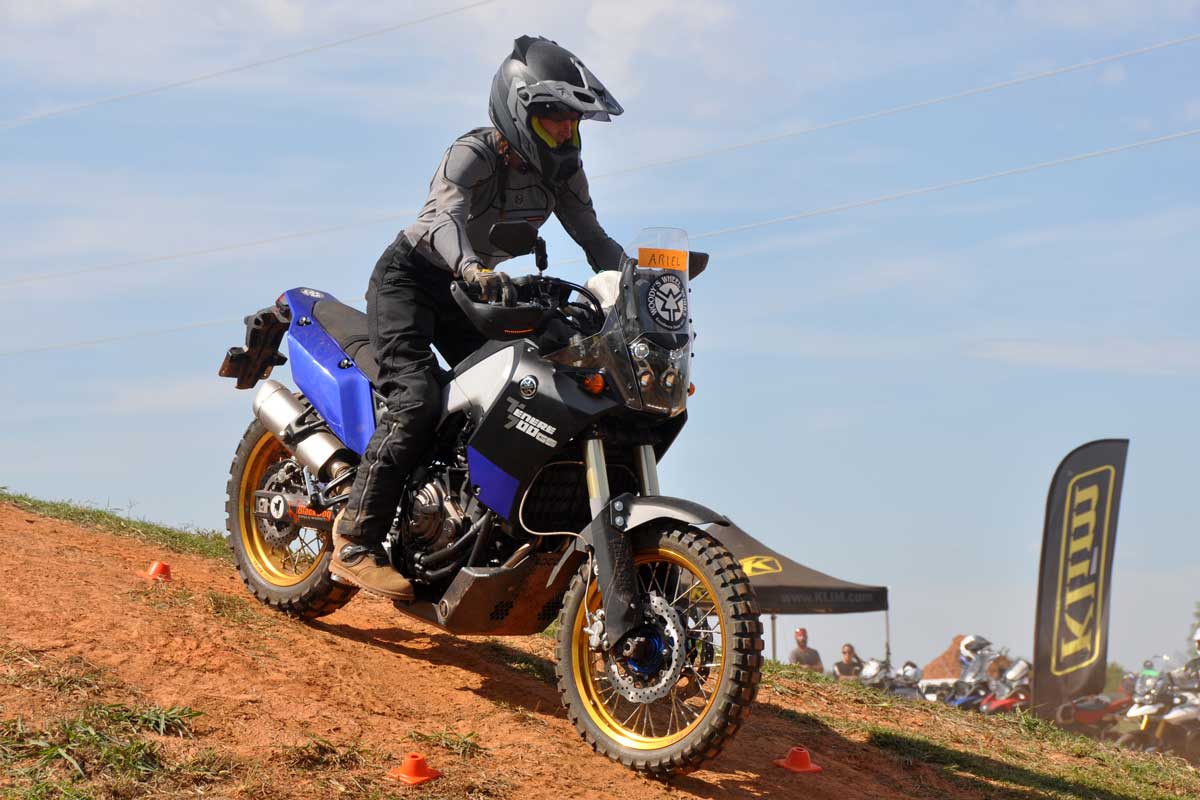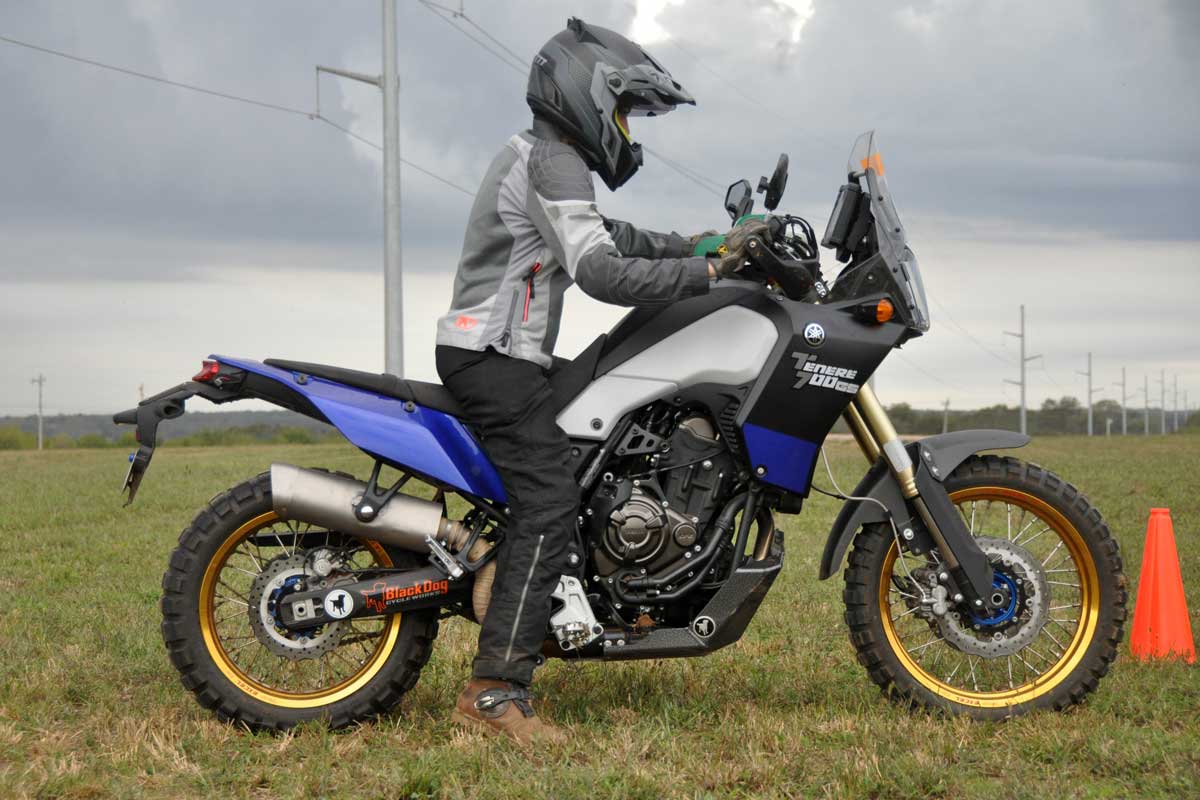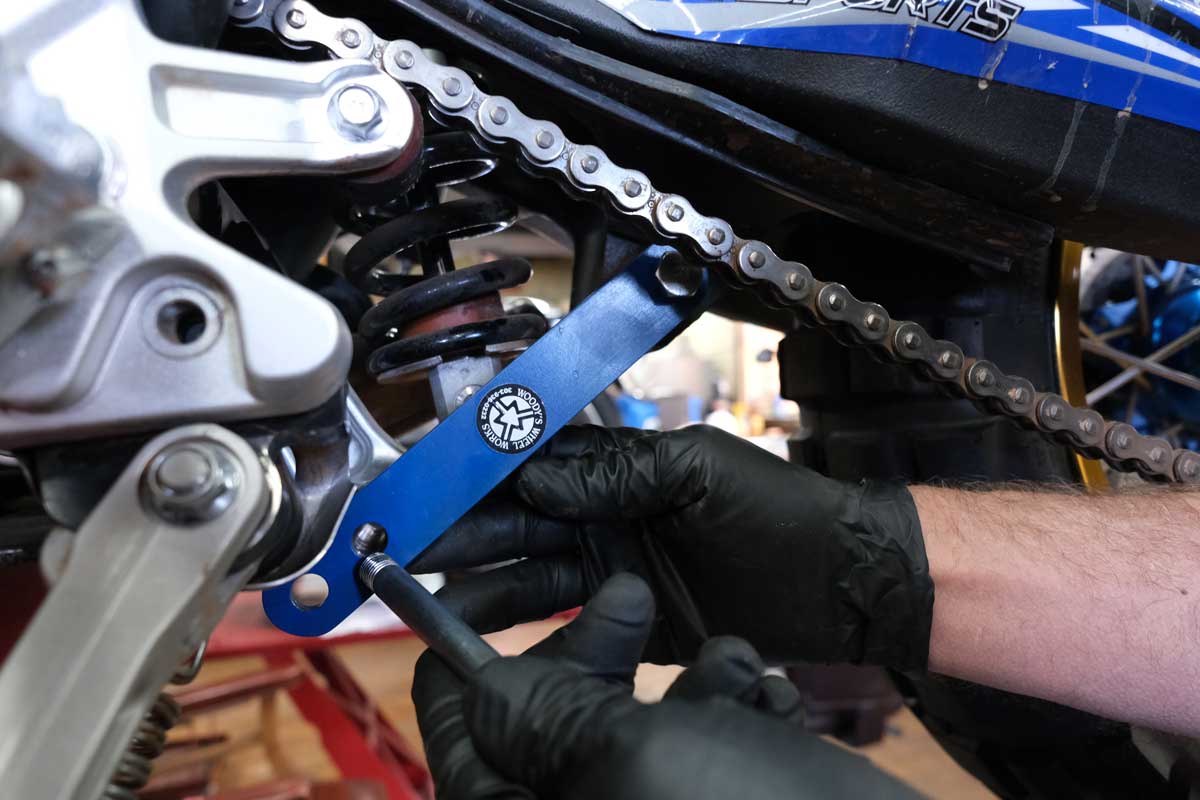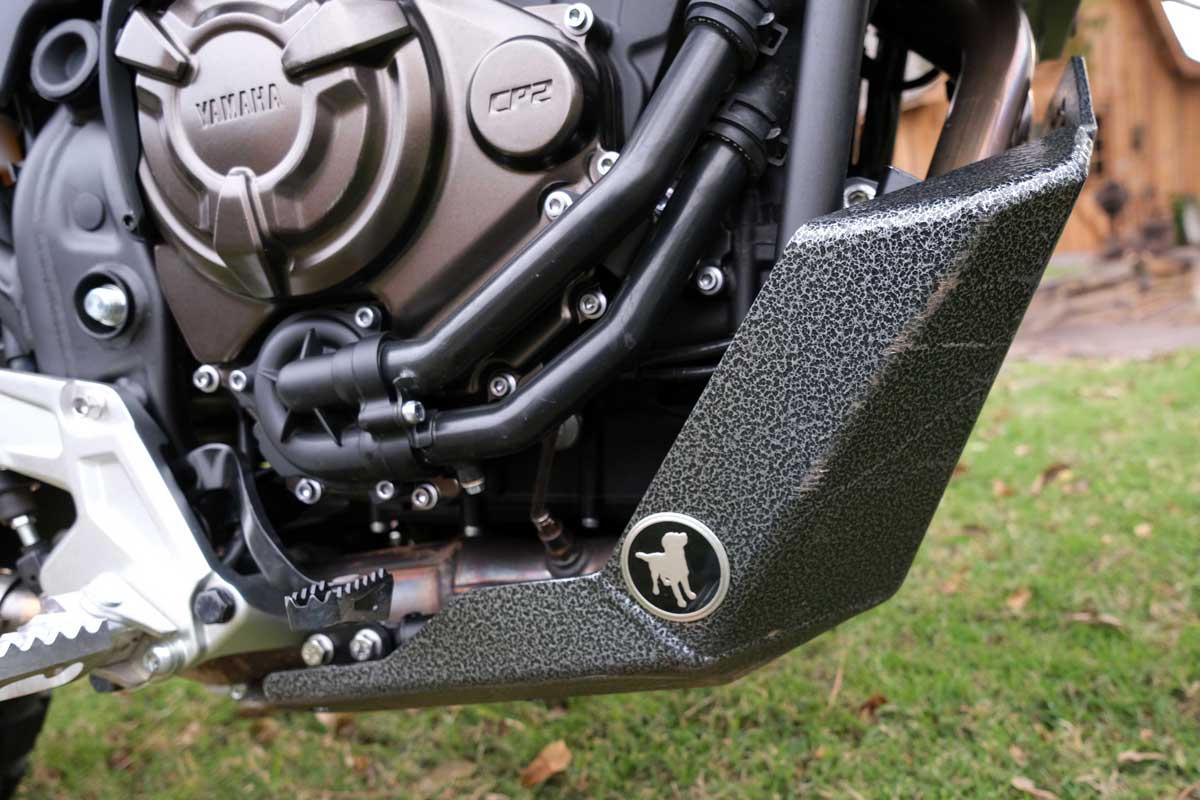Woody’s Wheelworks Yamaha Tenere 700 GS Convertible
Yamaha T7 / GS Convertible - How Low Can You Go?
The greater question is how low should you go, or better yet, should you even lower your motorcycle at all? Regardless of skill, sooner or later every rider must dab to prevent a fall. Riders with shorter inseams are at a disadvantage when this situation occurs, especially on sloped or uneven terrain. For those riders, Woody Witte has created a “convertible” bike in his T7 GS. This article is not intended to address every nuance of suspension setup and alteration, but hopefully it will provide some ideas for those who might otherwise shy away from off-road riding because the bikes are just too tall.
Log onto any dual-sport or adventure riding forum and sooner or later the question will come up. “Should I lower my bike?” Answers range from, “Never. The engineers know what works best,” to “You should definitely set up your bike in a way that allows both feet to be firmly planted on the ground.”
Lowering a motorcycle can be done in a number of ways, some better than others. Most adventure and dual-sport manufacturers offer a low seat option, and some even make lowered suspension and/or frames to accommodate shorter riders. The challenges induced by building a low motorcycle, however, are more critical for a motorcycle intended for off-road use than one that is bound only for street riding.

The “engineers know best” argument for tall suspension and seat height has plenty of merit. I’ve been a resident of that camp for most of my career as an internationally certified off-road motorcycle instructor, MSF instructor and somewhat of a purist. I’ve thought it best to leave things as God, or in our case, those who manufacture motorcycles, intended. In fact, exercise three in our D.A.R.T. curriculum is entitled, “Dispelling the Myth the Bike is Too Tall.” In this drill we practice methods to help keep the bike upright, within the “Cone of Balance,” (that zone of left and right movement beyond which the bike becomes too heavy to hold upright), by never having more than one foot on the ground at any given moment. The premise is that a tripod is never tipsy whereas a four-legged table is unstable on uneven ground. Most students quickly learn their limits and how to recognize when the bike is about to exceed them. Armed with this knowledge, and the ability to anticipate that scary point of no return, less muscle is required to prevent falls. Even so, for some, fear of dropping the bike demands more ground contact and a lower bike is the obvious answer.
The idea of keeping both feet on the ground is planted early for many riders in the first exercises of MSF training. These sessions begin with students waddling along in an extended duck walk fashion until they can secure a sense of balance. Then and only then do they raise their feet to the pegs. At that stage of learning, this isn’t necessarily a bad practice. Confidence greases the skids of learning and dropping the bike definitely throws ice water in the face of confidence. This quest for confidence is in tension against the irregularities of riding off pavement. Suspension travel and ground clearance are two of the most obvious issues associated with a lowered motorcycle. Crossing logs, ledges, even rises in terrain can be disconcerting when the engine or footpegs bottom out, especially for a less experienced rider who hasn’t learned the art of lofting the front wheel to clear obstacles.

Another concern caused by lowering suspension is that it changes handling dynamics, especially if improperly done. Slipping the fork tubes up in the triple clamps alone, for example, lowers the front end but also changes the rake and trail. Rake is the fork’s angle forward from the upper mounting points and trail, the measurement between the imaginary point where an extended fork would contact the ground and the point directly below the axle. Reducing one or both quickens steering and causes a tendency for the bike to turn in with less effort. Increasing rake or trail adds steering effort and slows handling while adding straight-line stability. Riders sometimes soften rear shock preload to compensate, which causes the suspension to bottom out more readily. Softening spring preload also slows the rebound action of the shock unless damping is reduced accordingly. Available payload is also decreased.
Lowering links are another method to reduce ride height in the rear but corresponding changes in leverage on the shock can create their own issues. Replacing the original shock or internal shock modifications can mitigate these concerns to a degree. They do however help by evening out the effect of lowering the front.

Evenly lowering both ends decreases trail to a small extent without affecting rake and lessens the nervous feel induced by the process. Motorcycle designers are always seeking that sweet combination of angles to create a good handling machine over the widest range of situations. Wouldn’t it be nice if we could minimize the negative effects of lowering a motorcycle while retaining many of the benefits of factory geometry? A lone hunt for the Holy Grail is often paved with big bucks and disappointment. Fortunately there are those like Woody who’ve paved that trail for us.
Most riders have had that moment where they wished they could have simply pushed a button and the bike would morph into a different kind of machine. Early in my riding career I wished for a Triumph 650 Bonneville when I was far from home (more than 10 miles or so) on my Honda CL 70. Later, when riding my Harley-Davidson Dyna Sport down some rough and rocky backroad, I pined for my tried-and-true Honda XL 250 Motorsport. The Motor Company took a stab at bridging the gap by inventing the Adaptive Ride Height option for their new Pan America, a system that adjusts itself on the fly, lowering the bike at the approach to a stop. But is paying upwards of $25,000 our only choice?
Woody Witte is a bonafide genius in the motorcycle wheel industry. He has also spent a lifetime helping disabled athletes compete in a world where they could not otherwise function by designing and manufacturing special accommodations for para-Olympians and even quadriplegics. Woody’s latest creation is a machine he calls his Yamaha T7 GS. Here, Woody applies his expertise in building custom wheels to the need for a lower version of Yamaha’s shining star middleweight. His theory is that if a 19” front and 17” rear setup works for BMW’s flagship adventure starship and many other big-bore dual-sport capable machines, it will also help shorter riders with a bike that fits but minimizes the typical issues caused by more aggressive lowering methods. Reducing wheel size adds a side benefit of increasing braking effectiveness and acceleration because of the reduced leverage the smaller diameters have on brakes and drive train.
At the core of his Yamaha T7 GS “Convertible” are his super strong, Superlaced and artistically designed custom wheels. The wheels alone pull approximately an inch from the factory ride height of 34.4”. With his wheels, the bike is almost equally lowered in the front and rear before the suspension is ever touched. The “convertible” aspect of his creation begins by simply slipping the forks up in the triple clamps, an action he balances with his adjustable lowering links for the rear. The overall effect is a machine that sits more than two inches lower but can be converted back to stock or a midway position with ease. The middle setting is accomplished by using his wheels alone and the high position on his lowering links and keeping the forks in their stock location. In the lowered configuration, the normally tall and gangly Tenere becomes a flat tracking, gravel road drifting Tasmanian Devil and it’s a blast to ride. If desired, the suspension can also be modified internally to match riding style, speed and skill. Touratech, for one, offers a 35mm front suspension lowering kit to internally modify the forks.
Click HERE to read about "Tenere 700 Touratech Shock and Fork Spring Install"

The prototype used for our test was outfitted with Black Dog Cycle Works’ skid plate, footpegs and luggage rack. The incredibly tough skid plate mitigates risk of engine damage from rock strikes on the lowered chassis and the oversized footpegs have the effect of adding power steering to an already nimble machine. Woody’s T7 GS Convertible prototype also came with the header pipe routed closer to the frame and a lightweight muffler, trimming the bike’s weight down even further.

As riders become more skillful, they tend to go faster and engage more difficult terrain. The T7GS Convertible adapts. Woody’s lowering links can be utilized in the low or stock position by moving one bolt. The strength, appearance and lower ride height facilitated by his 19/17-inch wheels increase the pure joy factor of this spirited machine, but if desired, they can be swapped back to the stock 21/18 setup in minutes.
Woody has taken the guesswork out of lowering a bike and replaced it with a system that just works. We can’t push a button to change the Tenere 700 GS Convertible but it’s pretty darn close.

Resources: WoodysWheelWorks.com | BlackDogCW.com | Touratech-USA.com
 Bill Dragoo is a BMW Motorrad Certified Off Road Instructor and owner of D.A.R.T., (Dragoo Adventure Rider Training) in Norman, Oklahoma. All brands are welcome. BillDragoo.com
Bill Dragoo is a BMW Motorrad Certified Off Road Instructor and owner of D.A.R.T., (Dragoo Adventure Rider Training) in Norman, Oklahoma. All brands are welcome. BillDragoo.com



